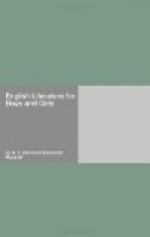Chapter III ONE OF THE SORROWS OF STORY-TELLING
The Tain gives us vivid pictures of people and things, but it is not full of beauty and of tender imagination like many of the Gaelic stories. Among the most beautiful and best known of these are perhaps the Three Sorrows of Story-Telling. These three stories are called: The Tragedy of the Children of Lir; The Tragedy of the Children of Tuireann; and Deirdre and the Sons of Usnach. Of the three the last is perhaps the most interesting, because the story happened partly in Scotland and partly in Ireland, and it is found both in old Irish and in old Scottish manuscripts.
The story is told in many old books, and in many ways both in prose and in verse. The oldest and shortest version is in the Book of Leinster, the same book in which is found The Tain.
The tale goes that one day King Conor and his nobles feasted at the house of Felim, his chief story-teller. And while they feasted a daughter was born to Felim the story-teller. Then Cathbad the Druid, who was also at the feast, became exceeding sad. He foretold that great sorrow and evil should come upon the land because of this child, and so he called her Deirdre, which means trouble or alarm.
When the nobles heard that, they wished to slay the new-born babe. But Conor spoke.
“Let it not be so done,” he said. “It were an ill thing to shed the blood of an innocent child. I myself shall care for her. She shall be housed in a safe place so that none may come nigh to her, and when she is grown she shall be my one true wife.”
So it was done as King Conor said. Deirdre was placed in a safe and lonely castle, where she was seen of none save her tutor and her nurse, Lavarcam. There, as the years passed, she grew tall and fair as a slender lily, and more beautiful than the sunshine.
Now when fourteen years had passed, it happened one snowy day that Deirdre’s tutor killed a calf to provide food for their little company. And as the calf’s blood was spilled upon the snow, a raven came to drink of it. When Deirdre saw that, she sighed and said, “Would that I had a husband whose hair was as the color of the raven, his cheeks as blood, and his skin as snow.”
“There is such a one,” said Lavarcam, “he is Naisi the son of Usnach.”
After that here was no rest for Deirdre until she had seen Naisi. And when they met they loved each other so that Naisi took her and fled with her to Scotland far from Conor the King. For they knew that when the King learned that fair Deirdre had been stolen from him, he would be exceeding wrathful.
There, in Scotland, Deirdre and Naisi lived for many years happily. With them were Ainle and Ardan, Naisi’s two brothers, who also loved their sister Deirdre well.
But Conor never forgot his anger at the escape of Deirdre. He longed still to have her as his Queen, and at last he sent a messenger to lure the fair lady and the three brave brothers back to Ireland.




